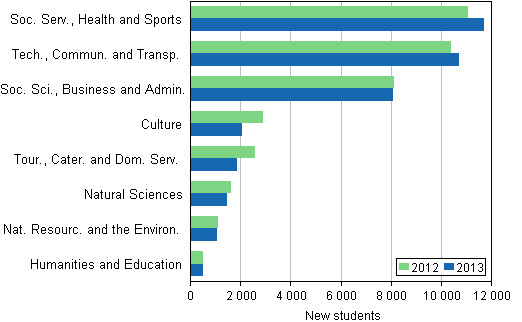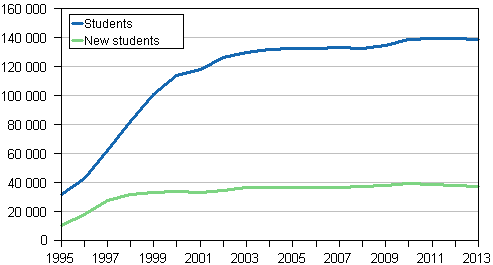This set of statistics has been discontinued.
Statistical data on this topic are published in connection with another set of statistics.
Data published after 5 April 2022 can be found on the renewed website.
Published: 15 November 2013
Number of new students in polytechnics decreased
According to Statistics Finland, the number of new students in polytechnic education leading to a qualification decreased by two per cent compared with the previous year. There were a total of 37,500 new students in the autumn of 2013. The heaviest decline in the number of new students was seen in the field of culture, over 28 per cent, and in the field of tourism, catering and domestic services, 27 per cent. The third highest decline in the number of new students was found in the field of natural sciences, almost eight per cent. In the field of health, welfare and sports and the field of technology and transport, the number of new students increased slightly.
New students in polytechnics by field of education (Educational Administration's classification) in 2012 to 2013

Reviewed by region, the number of new students decreased most in the region of Lapland, 13 per cent and in Central Ostrobothnia, 12 per cent. In the regions of Päijät-Häme and South Karelia, more than ten per cent fewer new students began their studies than in the year before. By contrast, the number of new students grew in the regions of Etelä-Savo, Kymenlaakso and Varsinais-Suomi.
New students and total number of students in polytechnics in 1995 to 2013

The total number of students also contracted compared with the previous year, by 0.7 per cent. Altogether, polytechnics had 138,900 students. The number of students attending education for young people leading to a polytechnic degree was 108,400 and in adult education leading to a polytechnic degree 21,900. The number of students attending education leading to a higher polytechnic degree grew. There were 8,600 such students, which is over 700 more than in 2012.
At 30 per cent of all students, there were most students in education leading to a polytechnic degree in the field of technology and transport. Altogether, 27 per cent of students were studying in the field of health, welfare and sports and 20 per cent in the field of social sciences, business economics and administration. At 33 per cent of all students, there were most students in education leading to a higher polytechnic degree in the field of health, welfare and sports. Altogether, 28 per cent of students in education leading to a higher polytechnic degree were studying in the field of social sciences, business economics and administration and 24 per cent in the field of technology and transport.
The number of students was highest at Helsinki Metropolia University of Applied Sciences, 16,300. The next highest numbers of students were found at Haaga-Helia University of Applied Sciences, 10,000, at Tampere University of Applied Sciences and at Turku University of Applied Sciences with over 9,600 students at both. The smallest polytechnic was the Police College of Finland with 90 students.
More detailed time series data on polytechnic students and new students by education, region of location of education and polytechnic are available in the appendix tables .
Source: Education. Statistics Finland
Inquiries: Anna Loukkola 09 1734 3678, koulutustilastot@stat.fi
Director in charge: Riitta Harala
Publication in pdf-format (273.7 kB)
- Tables
-
Tables in databases
Pick the data you need into tables, view the data as graphs, or download the data for your use.
Appendix tables
- Appendix table 1. New students and total number of students in polytechnics by type of education and fields of education (Educational Administration's classification) in 2012 to 2013 (15.11.2013)
- Appendix table 2. New students and total number of students in polytechnics by region of education in 2013 (15.11.2013)
- Appendix table 3. New students and total number of students in polytechnics by polytechnics in 2013 (15.11.2013)
- Appendix table 4. Students in polytecnics 1995 to 2013 and completed polytechnic degrees 1995 to 2012 (15.11.2013)
Updated 15.11.2013
Official Statistics of Finland (OSF):
University of applied sciences education [e-publication].
ISSN=2489-3196. Polytechnic education degrees 2013. Helsinki: Statistics Finland [referred: 15.1.2026].
Access method: http://stat.fi/til/akop/2013/02/akop_2013_02_2013-11-15_tie_002_en.html

